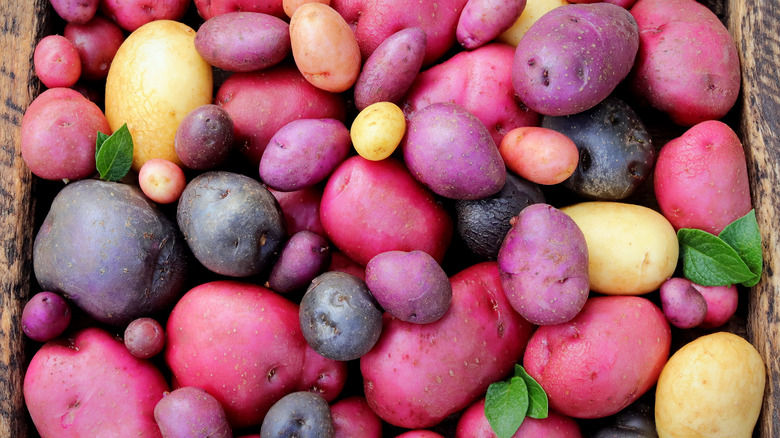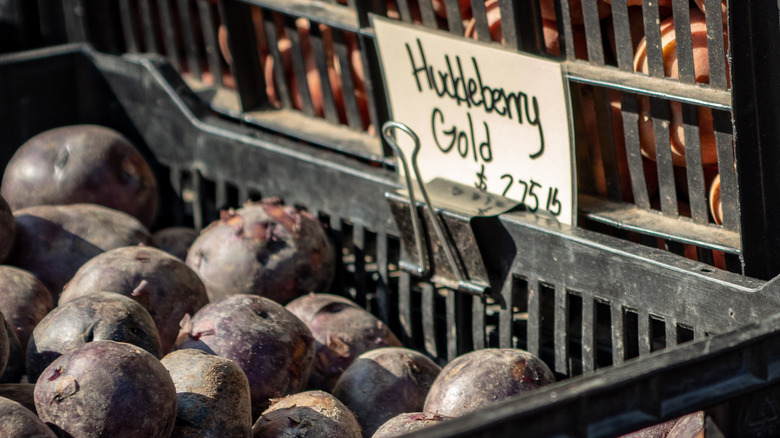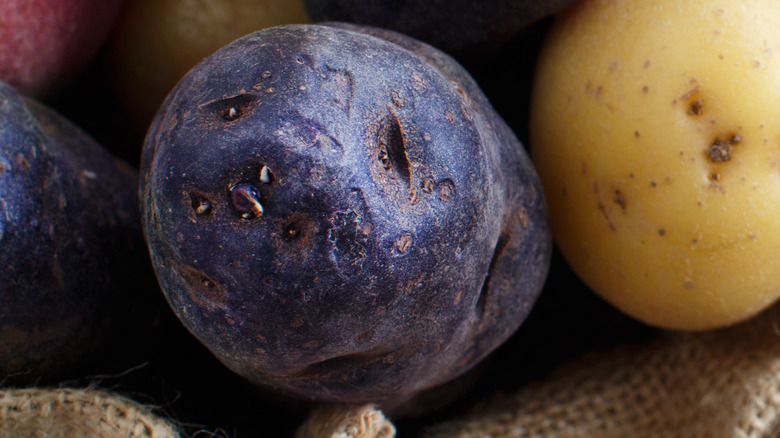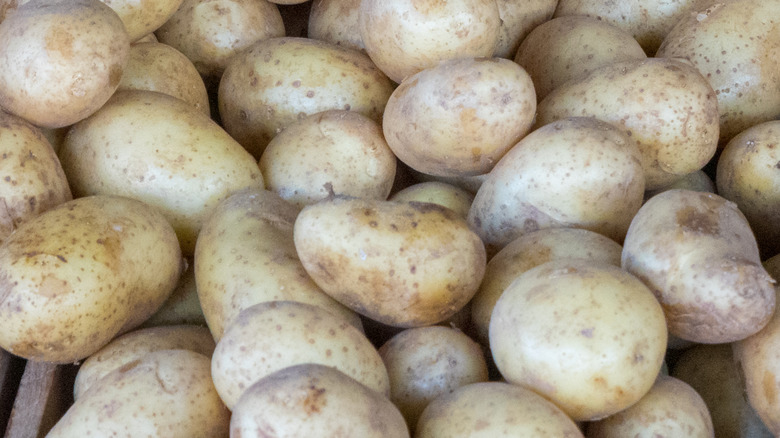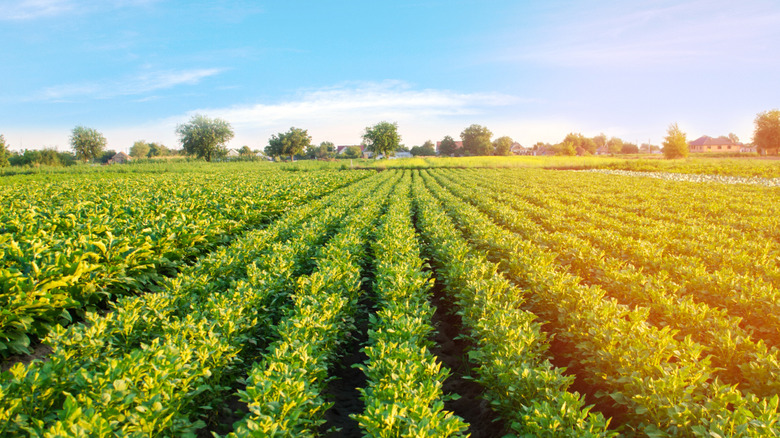The Vibrant Purple Potatoes Created By University Students
Francis Mallmann loves potatoes. The renowned Argentinian chef known for his joie de vivre, remote Patagonian island home, and open-fire cooking believes that potatoes are among the most elegant and adaptable foods available. They react to various cooking techniques that can alter their very nature, nursing out every last morsel of flavor, via Broken Palate. A simple glimpse at Mallmann's YesChef class or profile on Netflix's "Chef's Table" proves this point. However, despite his enthusiasm, Mallmann isn't the only person on earth who loves potatoes.
The Agricultural Marketing Resource Center states that potatoes are the number one most vital crop cultivated in the United States and the top five worldwide. Potatoes are grown commercially in 30 U.S. states, with Idaho leading the way as the highest producer. These root vegetables have been grown in Idaho since the mid-19th century. The century and a half of potato farming have produced outstanding crops year after year, and generations of farmers have made potatoes synonymous with the state, per the Idaho Potato Museum. Therefore, it seems only fitting that one of the most vibrantly beautiful potatoes ever created was developed by students and researchers at the University of Idaho's Aberdeen Research and Extension Center.
Origins of the Huckleberry Gold
Though the main campus for the University of Idaho sits in the northwesterly city of Moscow, which shares a border with another leading potato producer, Washington state, the Aberdeen Research and Extension Center lies at the heart of potato country. The southeast of Idaho has long been abundant in terms of potato production. As evidenced by the crop profile from the National IPM Database and regional map from Official Idaho Potatoes, the area in and around Aberdeen produces more potatoes than any other area of the state. In 1999, students and researchers at the Aberdeen center crossbred a female parent German varietal called 'Agria' with a male parent varietal from the University of Colorado called COA94019-5R. Four years later, in 2003, field testing and trials for the potato began, lasting until the official release of the Huckleberry Gold in 2011 by the Northwest Potato Variety Development Program (via the USDA).
According to the Government of Canada, the Huckleberry Gold received further field testing in New Brunswick in 2013, where it performed well during the growing season. The Huckleberry Gold has become successful in the specialty produce and commercial markets. According to The New York Times, despite being a potato developed in the west, an eastern company in Pennsylvania, Race-West, distributes the Huckleberry Gold nationwide.
Nutritional profile
Apart from their vibrant purple skin and cream gold flesh, the Huckleberry Gold potato is notable for being among the first potatoes known to have a low glycemic index. What does this mean? Most potatoes have higher sucrose levels, which are digested quickly and can rapidly boost blood sugar levels. The Huckleberry Gold, conversely, has a much lower sucrose level and, therefore, a low glycemic index, or GI. As research by Montana State University shows, the low GI levels in the Huckleberry Gold make it a fantastic potato option for those struggling with type 2 diabetes, who may be at risk of dangerous spikes in their blood sugar levels, via The Prairie Star.
Low GI levels are not the only nutritional benefit of these purple flavor nuggets. Like all potatoes, Huckleberry Gold is an excellent plant-based protein and Vitamin C source. However, according to Oregon State University, the antioxidant levels in Huckleberry Gold are much higher than in other potato varieties, and this is due to the Huckleberry's purple skin. Along with red-skinned potatoes, purple-skinned potatoes have significantly higher antioxidant levels than white or yellow-skinned varieties.
Similarities and differences to Yukon Gold
Some of these root vegetables stand out within the sphere of potato popularity in the United States. According to Statista, russet potatoes hold a 55% overall popularity, followed closely by red, white, and Yukon Gold. The Yukon Gold potato is a prized specialty known for its golden flesh and buttery flavor. Like the Huckleberry, the Yukon Gold is a medium-sized tuber with relatively few eyes, making them pleasing to look at and easy to prepare with the skin either on or peeled away. The Yukon does, however, tend to be flatter than the ovular Huckleberry. Developed in Canada in the 1960s, more than 30 years before the Huckleberry, the Yukon Gold is an established potato that thrives in fields across Canada and the United States, via Specialty Produce.
The immediately noticeable difference between the two potatoes is their respective skin colors. Where Yukon Gold has notably brown, yellowish skin, the skin of a Huckleberry is a deep, beautiful shade of purple. However, unlike the Huckleberry, the Yukon Gold has more heightened sucrose levels, meaning its glycemic index levels are much higher. However, the Yukon makes up for this with higher protein and Vitamin C, per Oregon State University. Both tubers share similar flavor profiles and are considered specialty produce in the wider market owing to their status as culinary favorites.
Cultivating Huckleberry Golds at home
Finding rare and unusual seeds to plant in our home gardens has never been easier. You can find seeds for Huckleberry Gold potatoes from venerated companies like Stark Bros., High Mowing Organic Seeds, and Renee's Garden. Their relative affordability and wide availability mean that you could grow a crop of Huckleberry Golds in your garden next season. According to Stark Bros., this potato can grow in USDA hardiness zones 3 through 9, making them easily adaptable to a wide range of climates. However, it is important to remember that all potato crops prefer full sun areas and like to be planted in a well-drained, loamy soil. Ensuring those key elements will lead to crop success.
The potatoes are best when sown no later than one to two weeks before your last frost date, which is something you can quickly look up online or in a local almanac. They take seven to eight weeks to grow and harvest, though if you are storing them for a while, wait an extra two weeks while the plants die back (via High Mowing Seeds). The Huckleberry Gold is moderately resistant to scab and blight but is particularly strong against the nematode-based Potato Virus X, per the USDA. Overall, this creation of the intrepid students and researchers of the University of Idaho is a flavorful and beautiful addition to add to your harvest garden.
